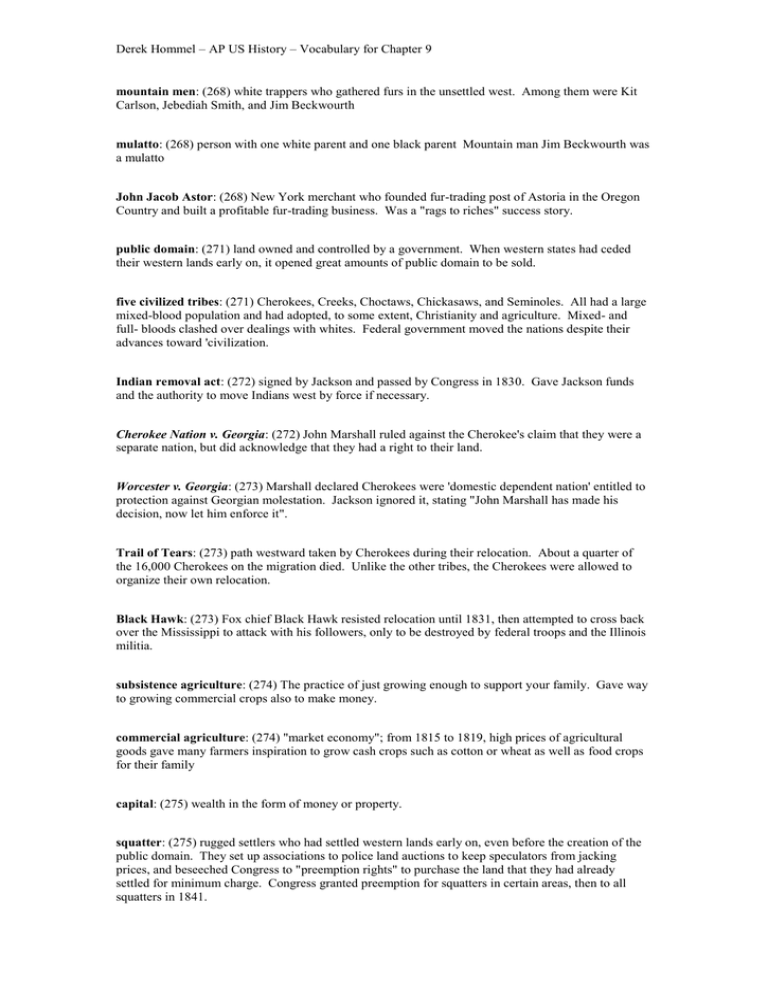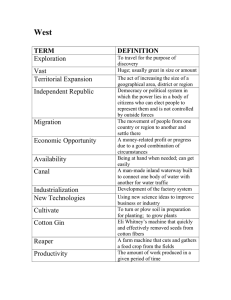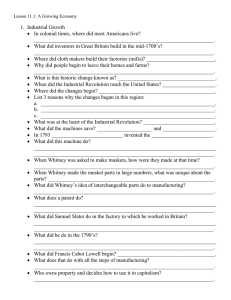Derek Hommel – AP US History – Vocabulary for Chapter... Carlson, Jebediah Smith, and Jim Beckwourth a mulatto
advertisement

Derek Hommel – AP US History – Vocabulary for Chapter 9 mountain men: (268) white trappers who gathered furs in the unsettled west. Among them were Kit Carlson, Jebediah Smith, and Jim Beckwourth mulatto: (268) person with one white parent and one black parent Mountain man Jim Beckwourth was a mulatto John Jacob Astor: (268) New York merchant who founded fur-trading post of Astoria in the Oregon Country and built a profitable fur-trading business. Was a "rags to riches" success story. public domain: (271) land owned and controlled by a government. When western states had ceded their western lands early on, it opened great amounts of public domain to be sold. five civilized tribes: (271) Cherokees, Creeks, Choctaws, Chickasaws, and Seminoles. All had a large mixed-blood population and had adopted, to some extent, Christianity and agriculture. Mixed- and full- bloods clashed over dealings with whites. Federal government moved the nations despite their advances toward 'civilization. Indian removal act: (272) signed by Jackson and passed by Congress in 1830. Gave Jackson funds and the authority to move Indians west by force if necessary. Cherokee Nation v. Georgia: (272) John Marshall ruled against the Cherokee's claim that they were a separate nation, but did acknowledge that they had a right to their land. Worcester v. Georgia: (273) Marshall declared Cherokees were 'domestic dependent nation' entitled to protection against Georgian molestation. Jackson ignored it, stating "John Marshall has made his decision, now let him enforce it". Trail of Tears: (273) path westward taken by Cherokees during their relocation. About a quarter of the 16,000 Cherokees on the migration died. Unlike the other tribes, the Cherokees were allowed to organize their own relocation. Black Hawk: (273) Fox chief Black Hawk resisted relocation until 1831, then attempted to cross back over the Mississippi to attack with his followers, only to be destroyed by federal troops and the Illinois militia. subsistence agriculture: (274) The practice of just growing enough to support your family. Gave way to growing commercial crops also to make money. commercial agriculture: (274) "market economy"; from 1815 to 1819, high prices of agricultural goods gave many farmers inspiration to grow cash crops such as cotton or wheat as well as food crops for their family capital: (275) wealth in the form of money or property. squatter: (275) rugged settlers who had settled western lands early on, even before the creation of the public domain. They set up associations to police land auctions to keep speculators from jacking prices, and beseeched Congress to "preemption rights" to purchase the land that they had already settled for minimum charge. Congress granted preemption for squatters in certain areas, then to all squatters in 1841. Derek Hommel – AP US History – Vocabulary for Chapter 9 preemption rights: (275) Rights granted to squatters in 1841 to let tem officially purchase land they had already settled for minimum charge. panic of 1819: (276) a drop in demand for agricultural goods in Britain made it so farmers could not repay debts. As the Bank of the United States cashed in state bank notes, state banks came to owe the Bank of the US, which forced them to make the farmers pay debts in order to repay the Bank of the US. Land speculators lost much money. Land values plummeted, since no one could afford to buy any new land. specie: (276) gold or silver; bank notes were able to be redeemed for specie. transportation revolution: (277) steamboats lowered shipping prices and enabled boats to go upstream. Steamboats also created a growth of a major canal system. Robert Livingston and Robert Fulton & the Clermont: (277) In 1807 Livingston and Fulton made the Clermont, which they used to ferry goods between New York and New Jersey via the Hudson River. They obtained a monopoly from the NY legislature. Gibbons v. Ogden: (277) Marshall ruled that the aforementioned monopoly was illegal. According to Marshall, commerce included navigation (inc. ferry services), and therefore the federal government had the right to regulate it. Erie Canal: (278) started in 1817. Longest canal in Western world up to that point. cottage industry: (282) household industries. Declined between 1815 and 1860 due to industrialization. Eli Whitney & Cotton Gin: (283) Cotton gin enabled the easier-growing cotton to be carded, enabling cotton industry to grow. Whitney later pioneered the manufacture of replaceable, identical parts. interchangeable parts: (283) Whitney demonstrated the use of creating identical parts when he created interchangeable parts for muskets. The idea originated in Britain but was widely practiced in America and was called the "American system of manufacturing". Samuel Slater: (283) moved to America in 1790 and created a cotton mill that carded and spun cotton. Slater contracted women to actually weave the cotton. Called the "putting out" system. Putting out system: (283) the idea of having independent household employees work in tandem with manufacturing factories. Demonstrated with Slater's hiring of women to weave his yarn. Boston Associates: (284) began the Waltham and Lowell cotton textile factories, changing the manufacturing business from the "putting out" system to factories doing all steps of manufacturing goods. Waltham and Lowell factories: (284) hired young women to work in factories. Much bigger than Slater's operation and broke tradition by hiring only women instead of families and having them live in dormitories away from home. Derek Hommel – AP US History – Vocabulary for Chapter 9 antebellum: (286) referring to pre-Civil War America Alexis de Tocqueville and Democracy in America: (286) Tocqueville was a French aristocrat in 1831 and wrote a two-volume Democracy in America summarizing his opinions on the pros and cons of democracy in America and its effects on the population. myth: (287) a story that exemplifies something. the "rags to riches" ideal in America was a myth. pauperism: (288) pauperism was the state of dependency of the poor people that differentiated them from 'bums' (eg drunkards). People believed that since pauperism hinged on personal problems such as being widowed or old age, it could not condemn groups of people generation after generation. Five Points District: (288) NYC slum. The Irish settled there and suffered discrimination due to not only poverty but their Catholicism middling classes: (289) farmers and artisans; neither poor nor fantastically rich; idealized selfemployment and often sought business ventures. transiency: (290) "Spatial mobility" or forced relocation: predominant in middling and lower classes. Farmers had to move when fields expired, and artisans had to move to find business. individualism: (290) the word began to take a positive meaning, reflecting self-reliance and economic independence Young Man's Guide and Letters to Mothers: (292) encouraged young people to control their own fates and establish a good reputation with self-control and develop character; women were urged to become more independent in their roles, and change such ideas as corporal punishment, instead using more emotional punishments. doctrine of separate spheres: 'separate-but-equal"; idea that women are superior at home and men are superior in the greater world such as politics. Popular in middle class. Andrew Jackson Downing: (293) designed single-home houses, which he thought would counter the busy life of Americans. Too expensive for most people of the time. vertical relationships: (294) relationship between superior and inferior horizontal relationships: (294) relationships between equals



